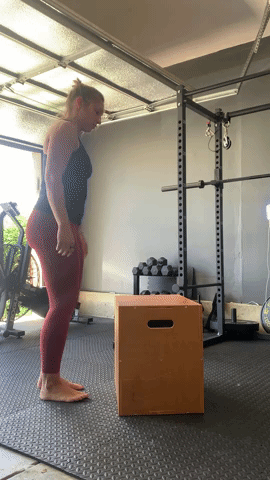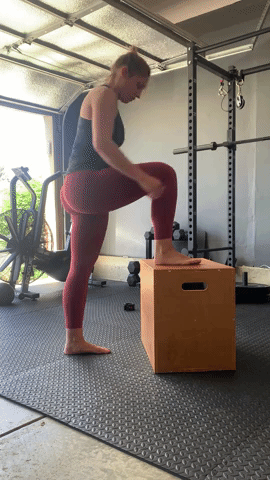Improve your step-up (Part 2)
Hey, hey! We’re back talking about how you can improve your step-up with a quick adjustment to form.
Last week we touched on the #1 issue I see with step-ups: starting on a soft surface that creates balance issues (read the full blog post about that here).
The second issue I commonly see when reviewing movement videos from my online clients also occurs at the initiation of the movement itself.
The hop.
It happens subtly and quickly.
And tends to be done subconsciously because, let’s face it, step-ups are hard and we like to find little ways to make them easier even if we don’t realize or mean to do it.
Most of the time if it’s not caught on video, you won’t even know you’re doing it.
The hop.
If you struggle to see where the hop happens, watch the knee of my standing leg. See the bend and bounce to get the step-up started? That’s exactly what we don’t want.
Instead of your working leg getting the full load during the step-up, some of that work is being done indirectly by the stance leg as it helps launch you up to the top of the movement. We don’t want that!
One of the reasons we work unilateral movements is to even out strength imbalances and to ultimately build more strength in bilateral movements (like your back squat).
If you find one leg is stronger than the other, it’s likely the stronger leg will help out your weaker side with this hop.
So, how do we fix it?
If you record yourself and see hopping in step-ups, there are a few things you can adjust.
Straighten that leg.
Before you change anything, think of the cues, “straight leg” and “shift the weight” as you work to lift yourself up. Focus on keeping your stance leg straight and think about shifting all of your weight forward onto your working leg as you lift off.
Sometimes the “fix” can be as simple as thinking about the movement more as you’re executing it.
But if that doesn’t do the trick for you, the next suggestion I have is to lower the box height or the weight you’re using (if any).
Most of the time this compensation occurs because of a lack of strength of the working leg. Lower the height of the step or the external load can modify this movement to match your current needs better… also gives you more ways to progress in the future!
Just like we said before, if you exhaust all of these options then it’s possible there are some other movements you should be working on improving before diving into a step-up.
A qualified coach will be able to help you sort out your specific approach to do this.
Have questions?
Drop them in the comments or send me a message to talk through it.
Chat soon-
Kirsi


